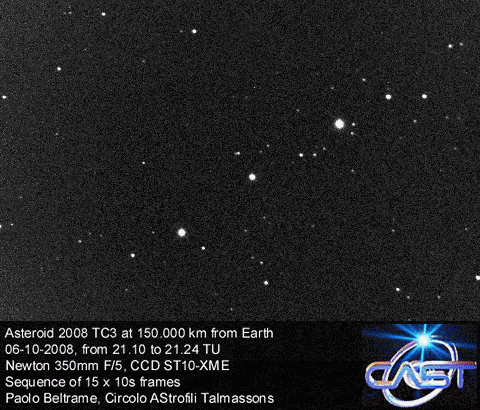 |
06/10/2008 21:10-21:24 T.U. |
Sequenza di Paolo BELTRAME |
Ripresa dall'Osservatorio Astronomico di Talmassons (Ud) |
Sezione Asteroidi |
 | ||||
| ASTEROIDE 2008 TC3 | ||||
| Diametro presunto: circa 3m | ||||
| Data della scoperta: 06:43 TU del 6 ottobre 2008 | ||||
| Data prevista per l'impatto con la Terra: 02:45:16 TU del 7 ottobre 2008 | ||||
| Località dell'impatto: Sudan settentrionale | ||||
La mattina del 7 ottobre 2008 l'autore della sequenza, Paolo Beltrame, ci scrisse: "Come segnalato ieri da Lucio Furlanetto e Rolando Ligustri, per
la prima volta è stato scoperto un asteroide che avrebbe sicuramente colpito la Terra. L'oggetto, nominato 2008 TC3 aveva circa 3 metri di
diametro e sembra proprio che si sia disgregato nell'atmosfera sopra il Sudan stamattina. Tutti gli astrofili attivi ieri sera si sono impegnati a fare
riprese e mandare misure per defire al meglio l'orbita dell'oggetto e, grazie alla segnalazione di Rolando, anch'io che ero in osservatorio ho dato il
mio contributo. Il veloce movimento dell'asteroide imponeva pose da soli 10 secondi, che ho intervallato di 60 secondi l'una dall'altra. L'oggetto era
molto vicino alla Terra, trovandosi a soli 150.000 km (0,001 UA)! Di seguito si riportano il testo della circolare CBET delle 19:31 UT del 6 ottobre 2008 che annunciava l'oggetto. Circular No. 8990
Central Bureau for Astronomical Telegrams
INTERNATIONAL ASTRONOMICAL UNION
Mailstop 18, Smithsonian Astrophysical Observatory, Cambridge, MA 02138, U.S.A.
URL http://www.cfa.harvard.edu/iau/cbat.html ISSN 0081-0304
2008 TC_3
A small asteroidal object (absolute magnitude H = 30.4,
suggesting a few meters in size) discovered by the Mt. Lemmon
Survey (observer R. A. Kowalski) on Oct. 6.28 UT at Delta = 0.0033
AU (about 1.27 the moon's distance from the earth) will enter the
earth's atmosphere over northern Sudan (according to S. Chesley,
Jet Propulsion Laboratory) around Oct. 7.115, moving west to east.
Prior to entering the atmosphere, it may be around visual mag 11.
Astrometry, orbital elements, and ephemerides are given on MPECs
2008-T50, 2008-T51, and 2008-T52.
La mattina successiva la ripresa, e dopo l'impatto contro l'atmosfera, nel sito di http://spaceweather.com si leggeva: ASTEROID IMPACT: If predictions were correct, asteroid 2008 TC3 hit Earth this morning (Oct. 7th at 02:46 UT), exploding in the atmosphere over northern Sudan like a kiloton of TNT and creating a fireball as bright as a full Moon. Most of the 3-meter-wide asteroid would have vaporized in the atmosphere with only small pieces possibly reaching the ground as meteorites. The following potentially confirming report comes from Jacob Kuiper, General Aviation meteorologist at the National Weather Service in the Netherlands: "Half an hour before the predicted impact of asteroid 2008 TC3, I informed an official of Air-France-KLM at Amsterdam airport about the possibility that crews of their airliners in the vicinity of impact would have a chance to see a fireball. And it was a success! I have received confirmation that a KLM airliner, roughly 750 nautical miles southwest of the predicted atmospheric impact position, has observed a short flash just before the expected impact time 02:46 UTC. Because of the distance it was not a very large phenomenon, but still a confirmation that some bright meteor has been seen in the predicted direction. Projected on an infrared satellite-image of Meteosat-7 of 0300 UTC, I have indicated the position of the plane (+) and the predicted impact area in Sudan (0)." 2008 TC3 was discovered on Oct. 6th by astronomers using the Mt. Lemmon telescope in Arizona as part of the NASA-funded Catalina Sky Survey for near-Earth objects. Asteroids the size of 2008 TC3 hit Earth every few months, but this is the first time one has been discovered before it hit. Come scritto nella pagina di Spaceweather.com il personale di un aereo dell'Air France-KLM ha effettivamente visto il bagliore dell' "esplosione" in aria.  L'animazione ha una dimensione di 480x415 pixel ed è a 256 colori; compressa occupa 314 KB. | ||||
| Telescopio: NEWTON di 350 mm diametro; lunghezza focale di 1750 mm; f/5 | ||||
| CCD: SBIG ST10XME | ||||
| Tempo d'integrazione: sequenza di 8 pose da 10 secondi ciascuna intervallate di 120 secondi | ||||
| Filtro impiegato: nessuno (unfiltered) | ||||
| Animazione linkata su Spaceweather.com il 07/10/2008 | ||||
Sistema Solare |
Fotografia, ccd e ricerca |
Articoli |
Dizionario
| ||||
